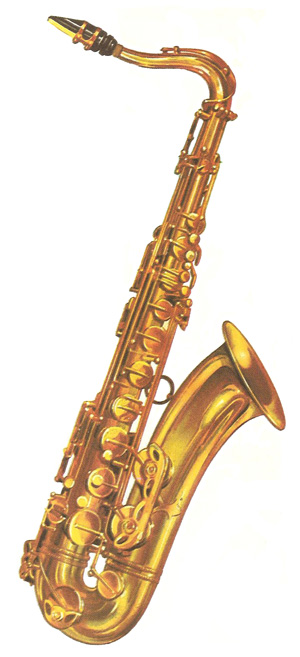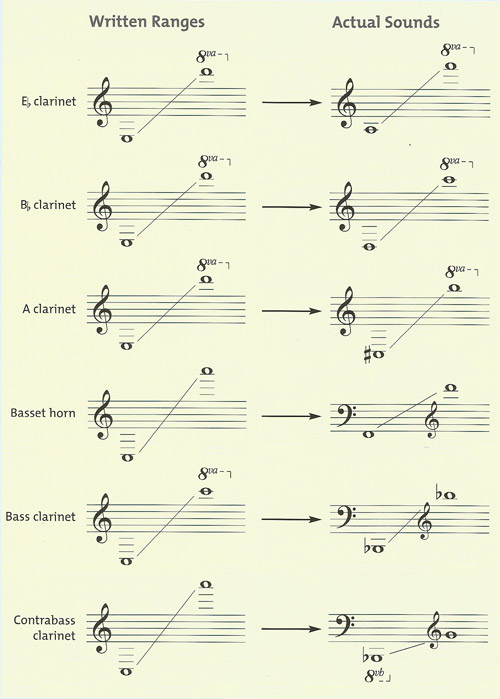saxophone

Saxophone.

Ranges of various kinds of saxophone.
The saxophone is classified as a woodwind instrument because of its use of a reed. It is named after Adolphe Sax who invented it in 1841 and established a patent for it in 1846. Of metal construction, it has a conical bore. Types of saxophone (listed from highest register to lowest) include sopranino, soprano, alto, tenor, and baritone. The saxophone has a reed mouthpiece, with sound created by blowing air past the reed, causing it to vibrate. Pitch is adjusted through a complicated series of keys and the sound is formed by the brass bell shape of the bore. The saxophone was particularly popular in early rock and roll as its raucous sound cut through the band to the dance floor without the need for amplification.
Before the saxophone
Adolphe Sax's father, Charles, was a successful instrument-maker and Adolphe himself had been involved in a number of instrument refinements and inventions – most notably the bass clarinet – prior to the creation of the saxophone. Sax seems to have been particularly interested in bass instruments, since the first saxophone stemmed from an attempt to improve the ophicleide – a keyed brass instrument developed in the early 1800s, which used a trombone-style mouthpiece. Through the advocacy of composers including Hector Berlioz (1803–1869), Guiseppe Verdi (1813–1901), and Richard Wagner (1813–1883), it had quickly established itself as the standard bass wind instrument of the orchestra, its obvious advantage of power and tone quality, however, were offset by erratic intonation and inconsistency of execution.
Sax attempted to solve these problems by combining various elements in one instrument. To a body resembling the ophicleide's he added new keywork and substituted the trombone-like mouthpiece for one much closer to that of the bass clarinet. The new instrument was paraded at the second Brussels Industrial Exhibition in August 1841 as a saxophone basse en cuivre ('bass saxophone made from brass').
The saxophone family
Berlioz heard Sax's creation and responded enthusiastically, reporting that "there is not a brass instrument to compare it with" and cementing the term 'saxophone' in the public mind. Buoyed by this success, Sax went on to create a family of saxophones and in 1846 applied for a patent for the design of 14 different instruments. By 1850, the standard family of six sizes was established with the contrabass as a rarely used extra.
Construction
The saxophone is a conically bored instrument with a flared bell. It widens considerably from mouthpiece to bell and consequently is capable of great power. It has between 22 and 24 note-holes, all of which are closed with keypads via a system of keys derived from the flute and clarinet systems. Like most wind instruments, the saxophone overblows at the octave; it uses two 'speaker keys' to facilitate the playing of higher notes. All saxophones have the same basic range from a written bb to a written f'' – but are transposing instruments.
With the exception of the sopranino saxophone, all the instruments require bending to make them a manageable length. This is done to a greater extent at the bell: the baritone saxophone almost doubles back on itself. The mouthpiece is detachable, as is the upper section of the body. The upper section is bent at right angles on the alto and tenor instruments to create an easy playing position. On the baritone and lower instruments, the upper section folds over itself to further reduce height.
Reed and mouthpiece
All saxophones produce sound with a single reed. The mouthpiece, made of ebonite, wood, metal, plastic, or glass, slopes down to meet the reed. Hollowed out, it is the shape of the mouthpiece chamber and the inlet that affect the sound. Saxophone mouthpieces are generally designed to fit over the neck of the instrument; an airtight fit is achieved with a thin cork sheet wrapped around the tip of the neck.
Sax retained the sole rights to the saxophone until 1866, at which point other manufacturers began developing their own models. Although some alterations in fingering and design took hold, the design of the saxophone has remained similar to Sax's original.
The sax in performance
The saxophone became a favorite of military bands in Europe. Its powerful tone and flexibility made it an ideal band instrument, particularly for performing outdoors. It was its presence in bands that took the instrument to the United States, where it rapidly grew in popularity. In the 1920s, the saxophone became a vital component in jazz and has since taken an equally strong position in many other branches of popular music; however, it never took root where Sax wanted it to – in the orchestra.
Versatility
The saxophone is perhaps one of the most flexible of instruments in terms of its variety of color and articulation. All saxophones play in a similar way – the fingering system is carried between instruments – and it is common for saxophonists to also play the clarinet. In addition, the saxophone is capable of a wide variety of avant-garde techniques, such as multiphonics, multiple tonguing, and glissandi.
Sopranino saxophone
With a sounding range of d♭' to a♭''', the E♭sopranino is the highest-pitched of the family. It is not generally used except in wind groups for creating special effects.
Soprano saxophone
A fourth lower than the sopranino, the B♭soprano's range extends from a♭ to e♭'''. Originally the soprano – like the sopranino – had a straight body. Equally common today is the soprano with an outward curve at the bell. This change in design creates a noticeably softer sound, both are difficult to play in tune. The soprano saxophone really made its mark in the hands of jazz saxophonist Sidney Bechet in the 1920s to 1950s.
Alto saxophone
Sounding an octave below the sopranino with a range of d♭to a♭'', the E♭alto and tenor saxophones are the most ubiquitous of the saxophone family. It was the alto that took the first orchestral parts and for which were written the two best-known concertos. But the alto sax is best known for the part it played in jazz. By the mid-1920s it was an established solo instrument and was brought to the forefront of this nascent musical form by players such as Johnny Hodges in Duke Ellington's band. The instrument's capacity to play everything from smooth, lyrical music to hard-edged bop fit perfectly with the idiosyncratic style of jazz musicians.
Tenor saxophone
Along with alto saxophone, the B♭tenor saxophone is the most successful of the family. With a range from A♭ to e♭'', it became the most prominent solo voice of the big band from the Swing Era onward. The saxophone is probably at its best in the tenor's tessitura; here its range of articulation and tone color allied to its remarkable dexterity has made it of the most expressive instruments in jazz.
The first major tenor saxophonist was Coleman Hawkins. His achievements inspired many subsequent generations of players, including Charlie Parker, John Coltrane, Stan Getz, Sonny Rollins, and Zoot Sims. Charlie Parker was influential himself in expanding the expressive range of the saxophone to include multiphonics and extremes of pitch and color.
Baritone saxophone
In spite of its low range, stretching from C to a♭', the baritone saxophone in E♭is more often used as a melody instrument than as the carrier of bass lines. The baritone saxophone player came into his own with Harry Carney of Duke Ellington's band and Jack Washington in Count Basie's orchestra. Gerry Mulligan took the solo baritone to new heights and established a style of playing that continues today.
Bass and contrabass saxophones
The lowest of the family in regular use, the bass saxophone in B♭has a range from A♭' to e♭'. Like the baritone saxophone, the bass is more commonly heard playing melodies than bass lines – in most wind and big bands the bass is taken by the tuba or double bass. Although popular at the beginning of the jazz era, the bass saxophone was rarely used after the 1930s until a revival of interest from the 1990s to the present day.
A perfect fourth lower than the bass, the contrabass saxophone's range extends from D♭' to a♭. Standing at 2 m (6.5 ft) in height, its only regular use has been to provide timbral variety to the bass saxophone.


